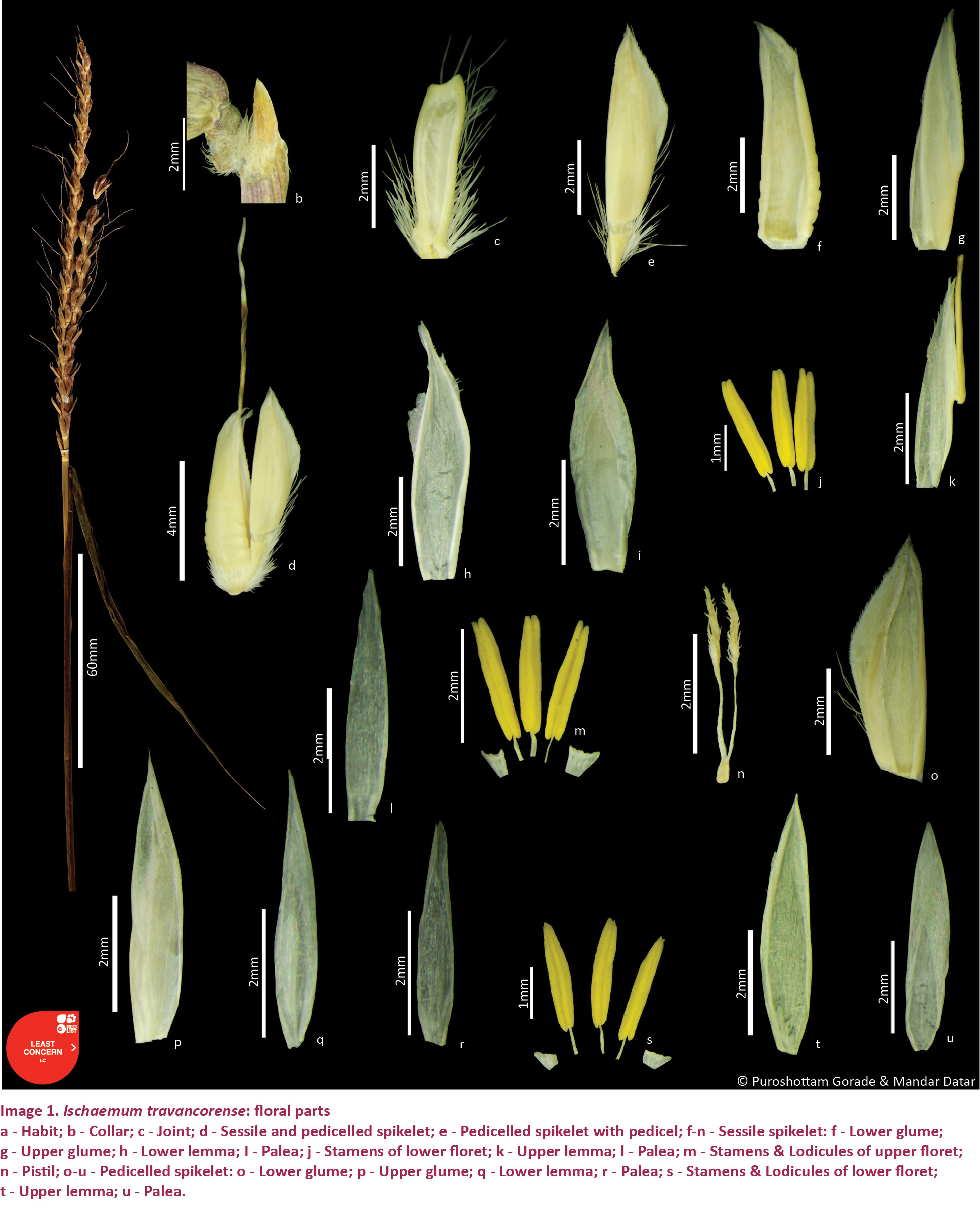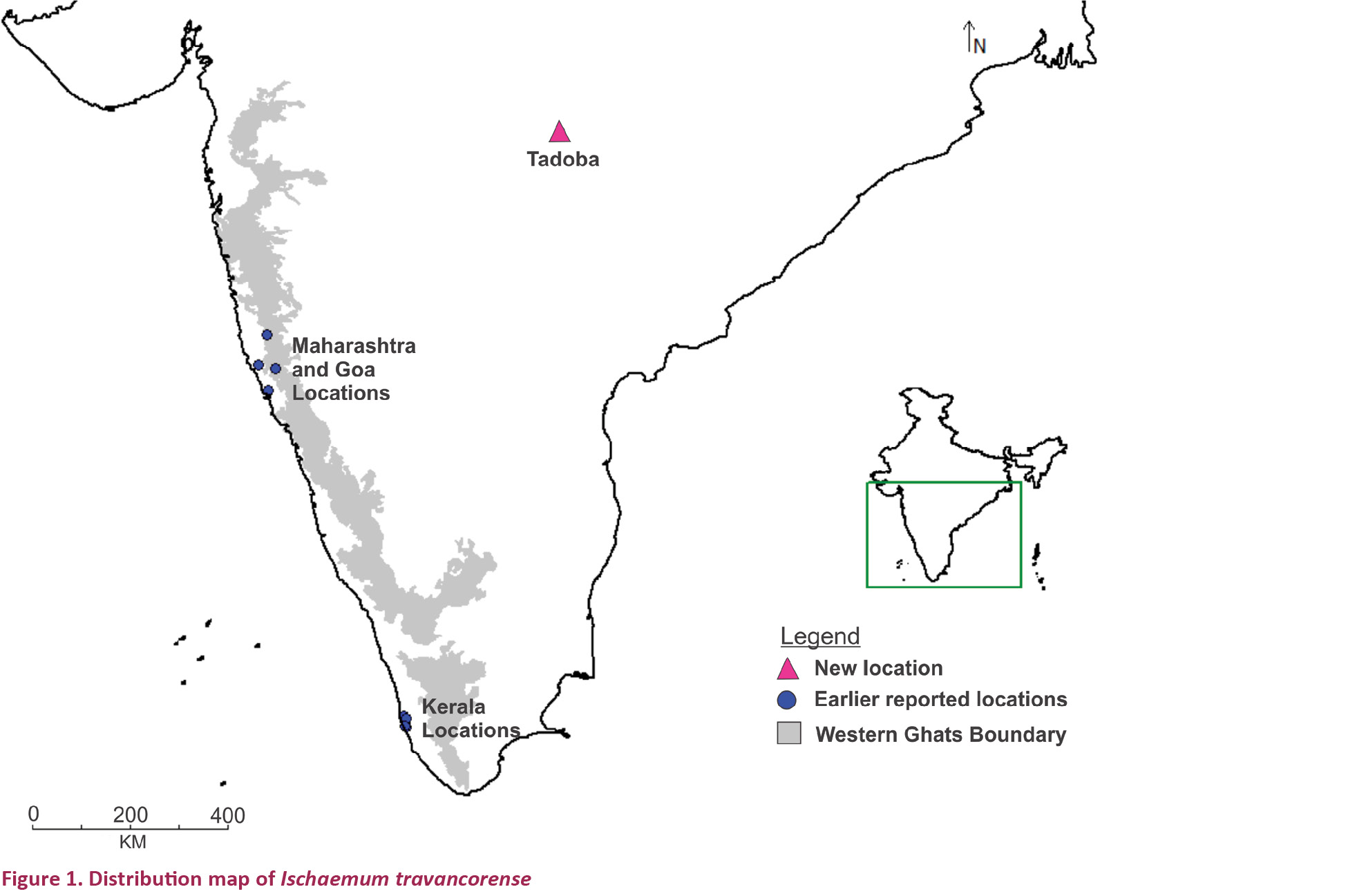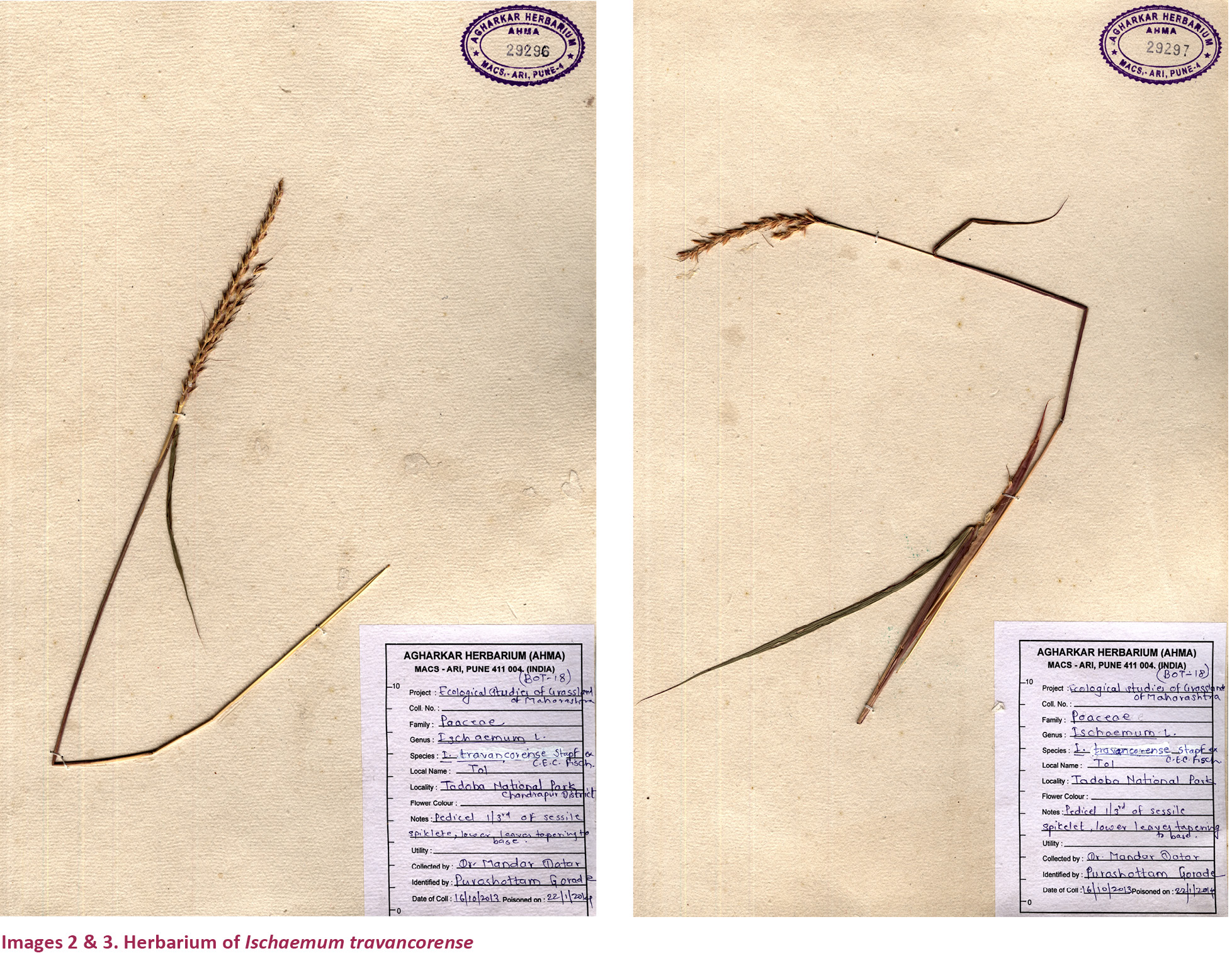Extended distribution of endemic Travancore Murainagrass Ischaemum travancorense Stapf ex C.E.C. Fisch. (Poaceae) to central India
Mandar N. Datar 1, Puroshottam Gorade 2, Pratibha Nadgir 3 & Abhijeet Bayani 4
1,2,3 Plant Sciences Division, Agharkar Research Institute, GG Agarkar Road, Pune, Maharashtra 411004, India
4 Indian Institute of Science Education and Research, Dr. Homi Bhabha Road, Pashan, Pune, Maharashtra 411008, India
1 mndatar@aripune.org (corresponding author),
2 puroshottam.gorade@gmail.com, 3 pratibhakatti85@gmail.com,
4 abhijeetbayani@gmail.com
doi: http://dx.doi.org/10.11609/JoTT.o4125.6733-6
Editor: N.P. Balakrishnan, Retd. Joint Director, BSI, Coimbatore, India. Date of publication: 26 December 2014 (online
& print)
Manuscript details: Ms # o4125 | Received 16 August 2014 | Final received 01 December 2014 | Finally accepted 03 December 2014
Citation: Datar, M.N., P. Gorade, P. Nadgir & A. Bayani (2014). Extended distribution of endemic Travancore Murainagrass Ischaemum travancorense Stapf ex C.E.C. Fisch. (Poaceae) to central India. Journal of Threatened Taxa 6(14): 6733–6736; http://dx.doi.org/10.11609/JoTT.o4125.6733-6
Copyright: © Datar et al. 2014. Creative Commons Attribution 4.0 International License. JoTT allows unrestricted use of this article in any medium, reproduction and distribution by providing adequate credit to the authors and the source of publication.
Funding: In-house funding of Agharkar Research Institute.
Competing Interest: The authors declare no competing interests.
Acknowledgements: Authors, MND, PG and PN are thankful to the Director, Agharkar Research Institute, Pune for providing necessary facilities for the work. Thanks to Dr. Girish Potdar, Assistant Professor, Department of Botany, Yashwantrao Chavan College of Science, Karad for confirming the identity of the species.

Genus Ischaemum belonging to the family Poaceae is distributed in warm and tropical regions having about 70 species (Mabberley 2008). In India the genus is represented by 51 species and infraspecific taxa (Sur 2001). Ischaemum travancorense Stapf ex C.E.C. Fisch. is an endemic and threatened species known from Kerala (Sreekumar & Nair 1991), from Goa (Joshi & Janarthanam 2004) and Maharashtra (Lakshminarasimhan 1996; Potdar et al. 2012). The known locations of this species are from the Western Ghats of Maharashtra, Goa and Kerala. The species is treated as endemic to the Western Ghats (Ahmedullah & Nayar 1986; Joshi & Janarthanam 2004) since all the known records are within the Western Ghats. Though it occurs in the northern (Maharashtra, Goa) and southern Western Ghats (Kerala), it is hitherto not known to be reported from the central Western Ghats, showing discontinuous distribution.
During our explorations for the study of grassland ecology of Maharashtra State this endemic and threatened species was found near Wadala–Tukum Village at the outskirts of Tadoba National Park in Chandrapur District of Maharashtra. This indicates an extended distribution of the species to central India. In the present communication, a brief citation, description, notes on ecology, illustration and distribution map are provided for the species.
Ischaemum travancorense Stapf ex C.E.C. Fisch. in Bull. Misc. Inform. Kew 353. 1933; Bor, Grasses Burma, Ceylon, India, Pak. 186. 1960; Karthik. et al., Fl. Ind. Enum. Monocot. 233. 1989; Sreekumar & Nair, Fl. Kerala - Grasses 165, f. 35. 1991; Lakshmin. in Sharma et al., Fl. Maharashtra, Monocot. 530. 1996; Sur in J. Econ. Taxon. Bot. 25(2): 433. 2001; Potdar, et al. Grasses of Maharashtra 203, fig. 85. 2012. I. aristatum subsp. rottleri Hook. f., Fl. Brit. Ind. 7: 127. 1896.
Perennial. Culms tufted, 60–150 cm tall. Leaf-sheath terete, 15–16 cm long. Leaf-blade linear-ovate, glabrous sparsely hairy, base rounded or cordate, apex acuminate. Racemes 2, appressed to each other, solitary. Joints clavate-turbinate, hairy on angles. Sessile spikelets oblong lanceolate, awned. Lower glume coriaceous, narrowly ovate-oblong, faintly 10–12 nerved, with a few side nodules joined by shallow ridges, 2-keeled, apex obtuse. Upper glume coriaceous, boat-shaped, 3–5 nerved, dorsally 1-keeled. Lower lemma membranous, narrowly ovate. Palea hyaline, narrowly ovate. Stamens 3. Upper lemma hyaline. Palea hyaline, narrowly ovate. Lodicules 2. Stamens 3. Pedicelled spikelets narrowly ovate oblong. Lower glume coriaceous, upper glume coriaceous, boat-shaped. Lemmas and palea similar to those in sessile spikelet but smaller. Upper lemma entire, awnless (Image 1).

Distribution: This species is known from the Alappuzha backwaters at Nedumudi, Pallana and Thottappaly areas of Kerala (Sreekumar & Nair 1991) and also from the Western Ghats of Goa (Joshi & Janarthanam 2004). In Maharashtra it is reported from Gaganbavada (Yadav & Sardesai 2002), Kudal-Bhadgaon, Sawantwadi-Amboli Ghat-Nanapani from Sindhudurg District (Kulkarni 1987) and Mumbai (Potdar et al. 2012). The present distribution is the first location outside the Western Ghats. The earlier known distribution of the species was between 090–160N & 730–760E. Now the present report has extended it to 200N and 790E (Fig. 1). This species is one of the examples of Wallacean shortfall, a shortfall where geographical distributions of taxa are poorly understood and contain many gaps (Whittaker et al. 2005). As in the majority of the endemic taxa, this may be due to inadequate collections from intermediate regions.

Phenology: In Wadala-Tukum Village (Tadoba National Park) flowering starts in September and grains are seen from October till January.
Exsiccata: 29296 and 29297 (AHMA), 16.x.13, Wadala-Tukum Village (Outskirts of Tadoba National Park) (Images 2 & 3).
Locality: Wadala Tukum, Outskirts of Tadoba National Park, Chandrapur District, Vidharba region of Maharashtra at 20.2943150N & 79.2566620E, 221m.
Ecological observations: It is a perennial grass growing along the streams, canals and backwaters, rice fields and also in marshy places. In Kerala, it is the most dominant and abundantly growing grass in the downstream deltaic portions. It is also abundant in the floating islands of the Kuttanad backwaters of Kerala, and the local population cut it and use it as fodder. Extensive areas of abandoned rice fields are now occupied by dense stands of Ischaemum as the climax community impenetrable to any other invader (Rehel 2013). In the Western Ghats of Maharashtra the species grows in waterlogged areas along the roadsides and rocky plateaus (Potdar et al. 2012). In the new locality also it is seen growing in marshy areas near rice fields forming clumps.
Endemism status: The species was considered to be endemic to the Western Ghats, now owing to its occurance in heavily altered agricultural systems like Alappuzha and its present report outside the Western Ghats, it should be considered to be endemic to peninsular India.
Threat status: As per the IUCN Red List version 3.1 Ischaemum travancorense is Least Concern (Rehel 2013).

References
Ahmedullah, M. & M.P. Nayar (1986). Endemic Plants of the Indian Region. Botanical Survey of India, Calcutta.
Joshi, V.C. & M.K. Janarthanam (2004). The diversity of life-form type, habitat preference and phenology of the endemics in the Goa region of the Western Ghats, India. Journal of Biogeography 31(8): 1227–1237; http://dx.doi.org/10.1111/j.1365-2699.2004.01067.x
Kulkarni, B.G. (1987). Flora of Sindhudurg. Botanical Survey of India, Calcutta, xx+605pp.
Lakshminarasimhan, P. (1996). Monocotyledones, p. 530. In: Sharma, B.D., S. Karthikeyan & N.P. Singh (eds.). Flora of Maharashtra State. Botanical Survey of India, Calcutta, 794pp.
Mabberley, D.J. (2008). Mabberley’s Plant-book: A Portable Dictionary of Plants, Their Classification and Uses. Cambridge University Press, 436pp.
Potdar, G.G., C.B. Salunkhe & S.R. Yadav (2012). Grasses of Maharashtra. Shivaji University, Kolhapur, 656pp.
Rehel, S. (2013). Ischaemum travancorense. The IUCN Red List of Threatened Species. Version 2014.2. <www.iucnredlist.org>. Downloaded on 28 July 2014.
Sreekumar, P.V. & V.J. Nair (1991). Flora of Kerala - Grasses. Botanical Survey of India, 475pp+fig. 35.
Sur, P.R. (2001). A revision of the genus Ischaemum Linn. (Poaceae) in India. Journal of Economic and Taxonomic Botany 25(2): 407–438.
Whittaker, R.J., M.B. Araújo, P. Jepson, R.J. Ladle, J.E. Watson & K.J. Willis (2005). Conservation biogeography: assessment and prospect. Diversity and Distributions 11(1): 3–23.
Yadav, S.R. & M.M. Sardesai (2002). Flora of Kolhapur District. Shivaji University, Kolhapur, xiv+589pp.
Note